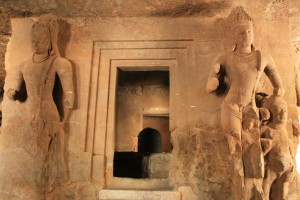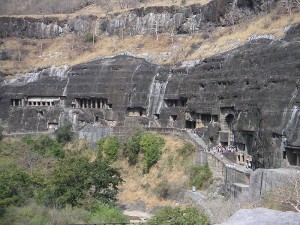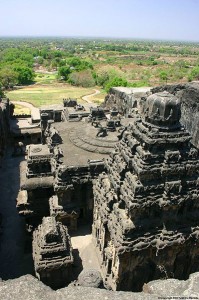Maharasthra is a diverse state in western India that includes coastal plains, vineyards, the Deccan Plateau and the Western Ghats. The region also has the largest number of caves in the country, some dating back to the 1st century BC. Making it even more convenient for travelers, several of the architectural caverns are an easy day trip from Mumbai. Mumbai, formerly Bombay, is the largest city in India and often considered the commercial and entertainment capital of the country. The almost 22 million residents create unique pockets of neighborhoods, each with their own cultural and culinary traditions.
The caves of Maharashtra are just as diverse as the Mumbai communities. The eclectic art and architecture reflect Hindu, Buddhist, and Jain traditions. Here are five of my favorites – pack a picnic and take a journey to the core of religious history:
Elephanta Caves
The 7th century rock-cut temples of Elephanta are located one hour by boat across Mumbai Harbor. Once known as Gharapuri, or the Fortress City, the caves are now designated as a UNESCO site and known for their historical and scenic value. The island houses five Hindu and two Buddhist caves, all carved from solid basalt rock. To date, no inscriptions or attribution have been found and many locals believe the site was created by deities.

Kanheri Caves
Only 42km from Mumbai, the Kanheri caves are excavated in volcanic breccia with hills rising 1550’ above sea level. Kanheri is also credited with the largest number of cave excavations in a single hill. The 109 caves served as a center of Buddhism and the carvings illustrate the Buddhist influence of art in ancient India. Nestled deep in Sanjay Gandhi National Park, the surrounding landscape also features rolling hills and waterfalls.
Karla –Bhaja Caves
The Bhaja caves are from the Hinayana phase of Buddhism, approximately 1st century BC. Built during Satavahana’s rule, the Karla Cave is the largest Hinayana Buddhist temple in India. Located near Lonavala, Karla is believed to be carved from a living rock and is considered one of the best examples of rock-cut architecture. Take your time ascending the stairs– it can be steep but the large windows carved in the rock to light the cave interiors is well worth the trek.
Ajanta Caves
Ajanta (and neighboring Ellora) is respected as among the top wonders in India. The Buddhist caves, from 200 BC, were used as temples and monasteries until abandoned for Ellora in AD 650. (The caverns were rediscovered by a British hunting group in 1819.) The sculptures and paintings are believed to have launched the Indian classical art movement. Considered a center of learning, the caves were separated for living, edification, and worship. Many traveling scholars and monks, including Dignaga, stayed here for extended periods of time.

Ellora Caves
With spaces dedicated to Jainism, Buddhism and Hinduism, Ellora showcases the universal civilization of ancient India. There are 34 caves and approximately 970 sequential monuments, with individual groupings of Buddhist, Brahmin, and Jain caverns. Original construction started in the 5th century AD, with additional caves built between the 8th and 10th centuries. The massive Kailasha Temple, designed to evoke Mount Kailish, is dedicated to Lord Shiva and covers an area twice the size of the Parthenon in Athens.



